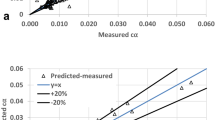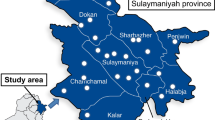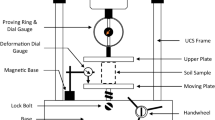Abstract
Consolidation settlement is a phenomenon happens in saturated fine-grained soils when subjected to change in effective stress. Consolidation settlement is often determined using the compressibility parameters, the compression index (\(Cc\)) and the recompression index \((Cr\)). However, there is lack of studies on the accuracy of the empirical correlations to predict the recompression index (\(Cr\)). In addition, no study has been concerned with the development of region-specific correlations to predict the recompression index of fine-grained soils in middle and north of Iraq. Thus, this research has been conducted to fill these gaps by collecting and testing of 350 undisturbed samples, assessing the available empirical correlations and developing of novel region-specific data-driven correlations to predict the recompression index \((Cr\)) using the evolutionary polynomial regression analysis (EPR-MOGA). The tests include the soil unit weight, specific gravity, water content, Atterberg limits and recompression index. The statistical assessment involved calculating the mean absolute error (\(MAE\)), root mean square error (\(RMSE\)), mean (\(\mu )\), percentage of predictions within error range of ± 30% (\(P30\)) and coefficient of correlation (\(R\)). In addition, 80% of the data has been used in the EPR-MOGA model training while 20% of data has been used to test (validate) the model accuracy. The results illustrate that all of the available correlations provide an average prediction of the recompression index with \(R\) ranges between 0.12 and 0.70, \(MAE\) ranges between 0.01 and 0.03, \(RMSE\) ranges between 0.020 and 0.030, \(\mu\) ranges between 0.26 and 1.73 and % \(P30\) ranges between 0 and 61%. However, the new EPR-MOGA correlations showed much better prediction capabilities, where the best EPR-MOGA correlation scored \(R\), \(MAE\), \(RMSE\), \(\mu\) and \(P30\) of 0.90, 0.01, 0.008, 1.05 and 82%, respectively, for training data and 0.88, 0.01, 0.009, 1.02 and 86%, respectively, for testing data. The new EPR-MOGA correlations require only the saturated unit weight, water content and void ratio of the soil to accurately predict the \(Cr\).










Similar content being viewed by others
References
Ahangar Asr A, Faramarzi A, Javadi AA (2018) An evolutionary modelling approach to predicting stress-strain behaviour of saturated granular soils. Eng Comput 35(8):2931–2952. https://doi.org/10.1108/EC-01-2018-0025
Alani AM, Faramarzi A, Mahmoodian M, Tee KF (2014) Prediction of sulphide build-up in filled sewer pipes. Environ Technol 35(14):1721–1728
Alkroosh I, Nikraz H (2014) Predicting pile dynamic capacity via application of an evolutionary algorithm. Soils Found 54(2):233–242
Alkroosh I, Alzabeebee S, Al-Taie AJ (2020) Evaluation of the accuracy of commonly used empirical correlations in predicting the compression index of Iraqi fine-grained soils. Innov Infrastruct Solutions 5(3):1–10
Alkroosh IS, Bahadori M, Nikraz H, Bahadori A (2015) Regressive approach for predicting bearing capacity of bored piles from cone penetration test data. J Rock Mech Geotech Eng 7(5):584–592
Alzabeebee S, Chapman DN (2020) Evolutionary computing to determine the skin friction capacity of piles embedded in clay and evaluation of the available analytical methods. Transport Geotech 24:100372
Alzabeebee S (2019) Seismic response and design of buried concrete pipes subjected to soil loads. Tunnel Undergr Space Technol 93:103084
Alzabeebee S (2020a) Application of EPR-MOGA in computing the liquefaction-induced settlement of a building subjected to seismic shake. Eng Comput. https://doi.org/10.1007/s00366-020-01159-9
Alzabeebee S (2020b) Dynamic response and design of a skirted strip foundation subjected to vertical vibration. Geomech Eng 20(4):345–358
Alzabeebee S, Chapman DN, Faramarzi A (2018) Development of a novel model to estimate bedding factors to ensure the economic and robust design of rigid pipes under soil loads. Tunn Undergr Space Technol 71:567–578
Alzabeebee S, Chapman DN, Faramarzi A (2019) Economical design of buried concrete pipes subjected to UK standard traffic loading. Proc Instit Civil Eng Struct Build 172(2):141–156
ASTM D1452 / D1452M-16, Standard practice for soil exploration and sampling by auger borings, ASTM International, West Conshohocken, PA, 2016, www.astm.org
ASTM D2216–19, Standard test methods for laboratory determination of water (moisture) content of soil and rock by mass, ASTM International, West Conshohocken, PA, 2019, www.astm.org
ASTM D2435 / D2435M-11, Standard test methods for one-dimensional consolidation properties of soils using incremental loading, ASTM International, West Conshohocken, PA, 2011, www.astm.org
ASTM D2487–17e1, Standard practice for classification of soils for engineering purposes (unified soil classification system), ASTM International, West Conshohocken, PA, 2017, www.astm.org
ASTM D4318–17e1, Standard test methods for liquid limit, plastic limit, and plasticity index of soils, ASTM International, West Conshohocken, PA, 2017, www.astm.org
ASTM D7263–09(2018)e2, Standard test methods for laboratory determination of density (unit weight) of soil specimens, ASTM International, West Conshohocken, PA, 2018, www.astm.org
ASTM D854–14, Standard test methods for specific gravity of soil solids by water pycnometer, ASTM International, West Conshohocken, PA, 2014, www.astm.org
Azzouz AS, Krizek RJ, Corotis RB (1976) Regression analysis of soil compressibility. Soils Found 16(2):19–29
Balacco G, Laucelli D (2019) Improved air valve design using evolutionary polynomial regression. Water Supply 19(7):2036–2043
Du Z, Shahin MA, El Naggar H (2021) Design of ram-compacted bearing base piling foundations by simple numerical modelling approach and artificial intelligence technique. Int J Geosynth Gr Eng 7(2):1–17
Giustolisi O, Savic DA (2006) A symbolic data-driven technique based on evolutionary polynomial regression. J Hydroinf 8(3):207–222
Giustolisi O, Savic DA (2009) Advances in data-driven analyses and modelling using EPR-MOGA. J Hydroinf 11(3–4):225–236
Gomes GJC, de Souza Gomes RG and do Amaral Vargas E (2021) A dual search-based EPR with self-adaptive offspring creation and compromise programming model selection Eng Comput 1–19
Güllü H, Canakci H, Alhashemy A (2018) Use of ranking measure for performance assessment of correlations for the compression index. Eur J Environ Civ Eng 22(5):578–595
Gunduz Z, Arman H (2007) Possible relationships between compression and recompression indices of a low-plasticity clayey soil. Arab J Sci Eng 32(2):179
Huang CF, Li Q, Wu SC, Liu Y, Li JY (2019) Assessment of empirical equations of the compression index of muddy clay: sensitivity to geographic locality. Arab J Geosci 12(4):122. https://doi.org/10.1007/s12517-019-4276-5
Işık NS (2009) Estimation of swell index of fine grained soils using regression equations and artificial neural networks. Sci Res Essays 4(10):1047–1056
Jin YF, Yin ZY (2020) An intelligent multi-objective EPR technique with multi-step model selection for correlations of soil properties Acta Geotechnica 1–21
Jin YF, Yin ZY, Zhou WH, Yin JH, Shao JF (2019) A single-objective EPR based model for creep index of soft clays considering L2 regularization. Eng Geol 248:242–255
Kassim KA, Rashid ASA, Kueh ABH, Yah CS, Siang LC, Noor NM, Moayedi H (2015) Development of rapid consolidation equipment for cohesive soil. Geotech Geol Eng 33(1):167–174
Kordnaeij A, Kalantary F, Kordtabar B, Mola-Abasi H (2015) Prediction of recompression index using GMDH-type neural network based on geotechnical soil properties. Soils Found 55(6):1335–1345
Kurnaz TF, Kaya Y (2018) The comparison of the performance of ELM, BRNN, and SVM methods for the prediction of compression index of clays. Arab J Geosci 11(24):770
Moayed RZ, Kordnaeij A, Mola-Abasi H (2017) Compressibility indices of saturated clays by group method of data handling and genetic algorithms. Neural Comput Appl 28(1):551–564
Nakase A, Kamei T, Kusakabe O (1988) Constitutive parameters estimated by plasticity index. J Geotech Eng 114(7):844–858
Nassr A, Esmaeili-Falak M, Katebi H, Javadi A (2018a) A new approach to modeling the behavior of frozen soils. Eng Geol 246:82–90
Nassr A, Javadi A, Faramarzi A (2018b) Developing constitutive models from EPR-based self-learning finite element analysis. Int J Numer Anal Meth Geomech 42(3):401–417
Onyejekwe S, Kang X, Ge L (2015) Assessment of empirical equations for the compression index of fine-grained soils in Missouri. Bull Eng Geol Env 74(3):705–716
Ozer M, Işık NS, Orhan M (2008) Statistical and neural network assessment of the compression index of clay-bearing soils. Bull Eng Geol Env 67(4):537–545
Rashed KA, Salih NB, Abdalla TA (2017) Correlation of consistency and compressibility properties of soils in Sulaimani city. Sulaimani J Eng Sci 4(5):86–94
Samui P, Shahin MA (2016) Relevance vector machine and multivariate adaptive regression spline for modelling ultimate capacity of pile foundation. J Numer Methods Civil Eng 1(1):37–45
Shams MA, Shahin MA, Ismail MA (2020) Design of stiffened slab foundations on reactive soils using 3D numerical modeling. Int J Geomech 20(7):04020097
Tinoco J, Alberto A, da Venda P, Correia AG, Lemos L (2020) A novel approach based on soft computing techniques for unconfined compression strength prediction of soil cement mixtures. Neural Comput Appl 32(13):8985–8991
Wang HL, Yin ZY, Zhang P, Jin YF (2020) Straightforward prediction for air-entry value of compacted soils using machine learning algorithms. Eng Geol 279:105911
Yin ZY, Jin YF (2019) Optimization-based evolutionary polynomial regression. Practice of optimisation theory in geotechnical engineering. Springer, Singapore, pp 71–99
Zhang W, Goh AT (2016) Multivariate adaptive regression splines and neural network correlations for prediction of pile drivability. Geosci Front 7(1):45–52
Zhang W, Zhang R, Wu C, Goh ATC, Lacasse S, Liu Z, Liu H (2020) State-of-the-art review of soft computing applications in underground excavations. Geosci Front 11(4):1095–1106
Funding
No funding was received for conducting this study.
Author information
Authors and Affiliations
Contributions
S. A. involved in conceptualization, methodology, validation, formal analysis, writing—original draft. Y. M. A. took part in methodology, writing—review & editing. A. J. A-T participated in methodology, writing—review & editing. K. A. R. took part in methodology, writing—review & editing.
Corresponding author
Ethics declarations
Conflict of interest
The authors declare no conflict of interest associated with this submission. In addition, the authors have no relevant financial or non-financial interests to disclose.
Data availability
Data used in this research are available upon request.
Code availability
Code used in this research is available upon request.
Additional information
Publisher's Note
Springer Nature remains neutral with regard to jurisdictional claims in published maps and institutional affiliations.
Rights and permissions
About this article
Cite this article
Alzabeebee, S., Alshkane, Y.M., Al-Taie, A.J. et al. Soft computing of the recompression index of fine-grained soils. Soft Comput 25, 15297–15312 (2021). https://doi.org/10.1007/s00500-021-06123-3
Accepted:
Published:
Issue Date:
DOI: https://doi.org/10.1007/s00500-021-06123-3




